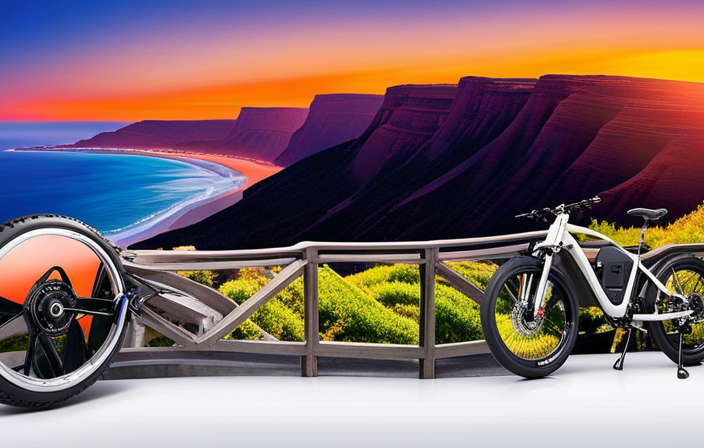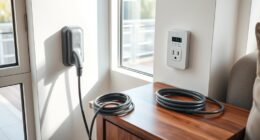Picture this: cruising down the streets effortlessly, feeling the wind in your hair, and leaving the world behind as you embrace the freedom of an electric bike.
But have you ever wondered what makes these bikes tick? What powers them to propel you forward with such ease?
In this article, we will delve into the fascinating world of electric bike motors. From hub motors to brushless DC motors, we will explore the different types of motors that make these bikes the revolutionary mode of transportation they are today.
So buckle up, because the ride is about to get electrifying!
Key Takeaways
- Electric bikes can use different types of motors, such as brushless DC motors.
- Regular maintenance and inspections are necessary to ensure the motor’s proper functioning.
- Future developments aim for lightweight and compact motors to enhance performance and maneuverability.
- Integration with smart technology allows for real-time data monitoring, customization, and improved safety and convenience.
Hub Motors
If you’re looking for an electric bike, you’ll find that they typically use hub motors. These motors are integrated into the center or rear wheel of the bike, providing a compact and efficient power source.
One advantage of hub motors is their integration with smart devices, allowing riders to monitor battery levels, adjust power settings, and track their rides through smartphone apps. Additionally, hub motors have a positive environmental impact as they produce zero emissions and contribute to reducing air pollution.
Now, let’s move on to the next type of motor commonly used in electric bikes, the mid-drive motors. These motors are located at the crankshaft of the bike, providing a more balanced and natural riding experience.
Mid-drive Motors
Mid-drive motors are commonly used in electric bikes because they offer several advantages over hub motors.
Firstly, mid-drive motors provide better weight distribution because they are located in the middle of the bike frame. This results in improved stability and maneuverability.
Additionally, mid-drive motors offer higher torque and efficiency compared to hub motors. This allows for better hill climbing and longer battery life.
However, mid-drive motors also have some disadvantages. They tend to be more expensive and require more maintenance due to their complex design. The added strain on the drivetrain can also lead to increased wear and tear on the bike’s components. Moreover, mid-drive motors can be noisier and produce more vibrations compared to hub motors.
Transitioning into the subsequent section on brushless DC motors, these motors offer even more advantages and are commonly used in electric bikes as well.
Brushless DC Motors
One advantage of brushless DC motors is their higher efficiency compared to other motor types. Brushless motors operate without brushes, which eliminates the need for friction and reduces energy loss. This results in a more efficient motor that can convert a higher percentage of electrical energy into mechanical power.
The efficiency of brushless motors is typically around 85-90%, while brushed motors usually have an efficiency of around 75-80%. This higher efficiency translates into several benefits for electric bikes. Firstly, it allows the bike to travel longer distances on a single charge, as less energy is wasted. Secondly, it helps to extend the lifespan of the battery, as less heat is generated during operation. Additionally, the improved efficiency of brushless motors contributes to a smoother and quieter ride.
As we move on to the next section about lithium-ion battery systems, it is important to consider how the efficiency of brushless motors can impact overall system performance.
Lithium-ion Battery Systems
To maximize the performance of your electric bike, it is crucial to understand the benefits and considerations of using lithium-ion battery systems.
Lithium-ion battery technology offers several advantages over other types of batteries commonly used in electric bikes. Firstly, they have a higher energy density, meaning they can store more energy in a smaller and lighter package. This results in increased range and improved overall bike performance. Additionally, lithium-ion batteries have a longer lifespan and can be charged faster than other battery types.
However, it is important to note that lithium-ion batteries require a specific charging infrastructure to ensure safe and efficient charging. This includes using a compatible charger and following proper charging protocols.
Now, let’s move on to the next section about ‘pedal assist sensors’ to explore another important component of electric bikes.
Pedal Assist Sensors
When it comes to pedal assist sensors, there are two main types to consider: torque sensors and cadence sensors.
Torque sensors measure the force applied by the rider while pedaling, providing a more natural and responsive assistance based on the rider’s effort.
On the other hand, cadence sensors simply measure the rotation speed of the pedals, providing a fixed level of assistance regardless of the rider’s effort.
Each sensor type has its own advantages and disadvantages, and understanding their differences is crucial when choosing an electric bike.
Torque Sensors
If you’re wondering about torque sensors, an electric bike uses them to measure the force applied to the pedals. Torque sensors are essential components that provide accurate information about the rider’s pedaling effort. This data is then used by the motor controller to determine the amount of power to deliver to the motor. Torque sensors offer excellent accuracy, ensuring that the motor provides just the right amount of assistance, whether it’s a gentle push or a powerful boost.
To help you better understand the importance of torque sensors, here’s a table highlighting their key features:
| Key Features | Description |
|---|---|
| Torque Sensor Accuracy | Measures the force applied to the pedals accurately |
| Torque Sensor Integration | Seamlessly integrates with the motor controller |
These features make torque sensors a crucial component in electric bikes, providing a more natural and intuitive riding experience. Now, let’s move on to the next section where we’ll explore cadence sensors and their role in electric bike motors.
Cadence Sensors
Cadence sensors measure the rotation speed of the pedals, providing crucial data for electric bike motors. Here are three key advantages of using cadence sensors over torque sensors:
-
Simplicity: Cadence sensors are easier to install and calibrate compared to torque sensors. They simply attach to the crank arm of the bike and measure the rotation speed.
-
Cost-effectiveness: Cadence sensors are typically less expensive than torque sensors, making them a more affordable option for electric bike manufacturers and consumers.
-
Consistency: Cadence sensors provide a consistent level of assistance regardless of the force applied to the pedals. This ensures a smooth and predictable riding experience, especially for riders who may have varying levels of strength or prefer a consistent level of assistance.
Transitioning into the subsequent section about throttle control systems, it is important to note that throttle control systems offer a different approach to electric bike motor assistance.
Throttle Control Systems
To control the speed of your electric bike, you can use a throttle control system. This system allows you to accelerate or decelerate the bike with ease. The throttle control is typically located on the handlebars and can be operated with your thumb or twist grip.
One of the main advantages of a throttle control system is the ability to have variable throttle speed. This means that you can adjust the speed of your electric bike according to your preference, whether you want to go faster or slower.
Additionally, some electric bikes with throttle control systems also have regenerative braking, which helps to recharge the battery when you brake. This feature can extend the range and battery life of your electric bike.
Speaking of range and battery life…
Range and Battery Life
The range and battery life of an electric bicycle can vary depending on factors such as terrain and riding style. Battery capacity plays a crucial role in determining how far an electric bike can go on a single charge. The higher the battery capacity, the longer the range. Additionally, the availability of charging infrastructure also affects the overall battery life. Having convenient charging stations can extend the range by allowing riders to recharge their batteries on the go. To provide a visual representation, consider the following table:
| Terrain | Riding Style | Range (miles) |
|---|---|---|
| Flat | Moderate | 40-60 |
| Hilly | Aggressive | 20-30 |
| Mountainous | Casual | 10-15 |
Understanding the range and battery life is essential for riders to plan their journeys accordingly and make use of the available charging infrastructure. This knowledge segues into the subsequent section about power and speed limitations.
Power and Speed Limitations
When it comes to power and speed limitations of electric bikes, there are two key points to consider: legal restrictions and classifications of electric bikes.
In terms of legal restrictions, different countries and states have their own regulations on the maximum power output and top speed allowed for electric bikes. These restrictions are put in place to ensure the safety of riders and other road users.
Additionally, electric bikes are often classified into different categories based on their power output and top speed, such as Class 1, Class 2, and Class 3, which further determine where they can be ridden and whether they require a license or registration.
Legal Restrictions
You can find legal restrictions on the type of motor an electric bike can use. These regulations are put in place to ensure the safety of riders and pedestrians. Here are some of the key safety measures that these restrictions enforce:
-
Power Limitations: Electric bikes are typically limited to a certain power output, such as 750 watts in many countries. This prevents the bike from reaching excessive speeds and helps maintain control.
-
Speed Limitations: Electric bikes are also subject to speed restrictions, which vary depending on the region. These limits help prevent accidents caused by high speeds and ensure that electric bikes can safely navigate through traffic.
-
Pedal Assistance Requirement: In many jurisdictions, electric bikes must have a pedal-assist feature, meaning the motor only provides assistance when the rider is pedaling. This requirement promotes physical activity and reduces the risk of accidents.
These legal restrictions on motor type, power, and speed help create a safer environment for electric bike riders and those around them.
Moving on to the next section, let’s delve into the classifications of electric bikes.
Classifications of Electric Bikes
Now that we’ve discussed the legal restrictions surrounding electric bikes, let’s dive into the classifications of electric bike motors.
Understanding the different types of motors is essential when choosing an electric bike that suits your needs. Electric bike motors can be classified into three main categories: hub motors, mid drive motors, and friction drive motors.
Hub motors are the most common type, located in the wheels, and provide a smooth and quiet ride.
On the other hand, mid drive motors are positioned in the center of the bike and offer several advantages, including better balance, improved hill climbing ability, and increased range. With their ability to utilize the bike’s gears, mid drive motors provide efficient power transfer and a more natural riding experience.
Now, let’s explore the next section on maintenance and repairs, where we’ll learn how to keep our electric bikes in optimal condition.
Maintenance and Repairs
The most common type of motor used in an electric bike is a brushless DC motor. These motors are preferred due to their high efficiency, low maintenance requirements, and long lifespan.
When it comes to maintenance, there are a few key tips to keep in mind. Regularly inspecting the motor for any signs of damage or wear is important, as well as keeping it clean and free from dust and debris. It’s also recommended to lubricate the motor bearings and check the wiring connections periodically.
In terms of common repairs, issues with the motor controller or battery connections are often encountered. Additionally, replacing worn-out brake pads and tires is essential for optimal performance and safety.
Looking ahead, future developments and innovations in electric bike motors aim to improve power output, efficiency, and overall performance. Transitioning into the subsequent section, these advancements will undoubtedly shape the future of electric biking.
Future Developments and Innovations
In the future, electric bikes are expected to feature lightweight and compact motors, allowing for easier maneuverability and improved performance. These motors will be designed to provide sufficient power while minimizing the overall weight of the bike, making it more agile and efficient.
Additionally, there will be advancements in integrating electric bikes with smart technology. This integration will enable features such as real-time data monitoring, navigation assistance, and connectivity with smartphones or wearable devices.
This integration will enhance the overall user experience, providing a seamless and convenient way to control and interact with the electric bike.
Lightweight and Compact Motors
You can choose a lightweight and compact motor for your electric bike. When considering the motor efficiency and power output, these compact motors are designed to deliver optimal performance while reducing weight and size.
The advancements in motor technology have allowed for the development of smaller yet powerful motors that can easily fit into the frame of an electric bike. These motors are engineered to provide high torque and efficient power delivery, ensuring a smooth and responsive ride.
Additionally, their compact size allows for better integration with other components of the electric bike, such as the battery and controller. This integration with smart technology further enhances the overall efficiency and performance of the electric bike.
With a lightweight and compact motor, you can enjoy a powerful and efficient electric bike ride while taking advantage of advanced smart features.
Integration with Smart Technology
By integrating smart technology, lightweight and compact motors enhance the overall efficiency and performance of electric bikes.
With smartphone connectivity, riders can easily control and monitor their electric bikes through dedicated mobile applications. This allows them to track their speed, distance traveled, battery life, and even customize riding modes.
Voice control integration takes it a step further, enabling riders to control various functions of the electric bike through voice commands. This hands-free feature enhances safety and convenience while riding.
For example, riders can adjust the pedal assist level or turn on/off the lights simply by speaking commands.
The integration of smart technology not only adds a futuristic touch to electric bikes but also makes them more user-friendly, efficient, and enjoyable to ride.
Frequently Asked Questions
Are there any safety concerns related to using a hub motor in an electric bike?
Yes, there are safety concerns associated with using a hub motor in an electric bike. These concerns include overheating, potential damage to the motor and wheel, and increased risk of injury due to the added weight and torque.
How does a mid-drive motor differ from a hub motor in terms of performance and efficiency?
A mid-drive motor offers several advantages over a hub motor in terms of performance and efficiency. It provides better weight distribution, increased torque for climbing hills, and a more natural riding experience. In contrast, hub motors can be heavier, less efficient, and may affect the bike’s handling.
Can a brushless DC motor be used in any type of electric bike, or are there specific requirements?
A brushless DC motor can be used in various types of electric bikes, but there are specific requirements. These include factors such as voltage and power ratings, compatibility with the bike’s controller, and the ability to provide sufficient torque and efficiency for the desired performance.
What factors should be considered when choosing a lithium-ion battery system for an electric bike?
When considering a lithium-ion battery system for an electric bike, factors and considerations must be evaluated. One important statistic is that the energy density of lithium-ion batteries has increased by 5-8% annually over the past decade.
Are there any legal restrictions on the use of throttle control systems in electric bikes?
Legal restrictions on throttle control systems for electric bikes vary by jurisdiction. Safety concerns with hub motors include potential instability at high speeds and decreased control on slippery surfaces.
Conclusion
In conclusion, electric bikes utilize different types of motors, including hub motors and mid-drive motors. These motors provide efficient and reliable power, allowing riders to enjoy a smooth and comfortable ride.
One interesting statistic is that brushless DC motors, commonly used in electric bikes, have an efficiency rate of over 80%. This means that more than 80% of the electrical energy is converted into mechanical energy, making electric bikes an environmentally-friendly and energy-efficient mode of transportation.
As technology continues to advance, we can expect further developments and innovations in electric bike motors, providing even better performance and functionality.









